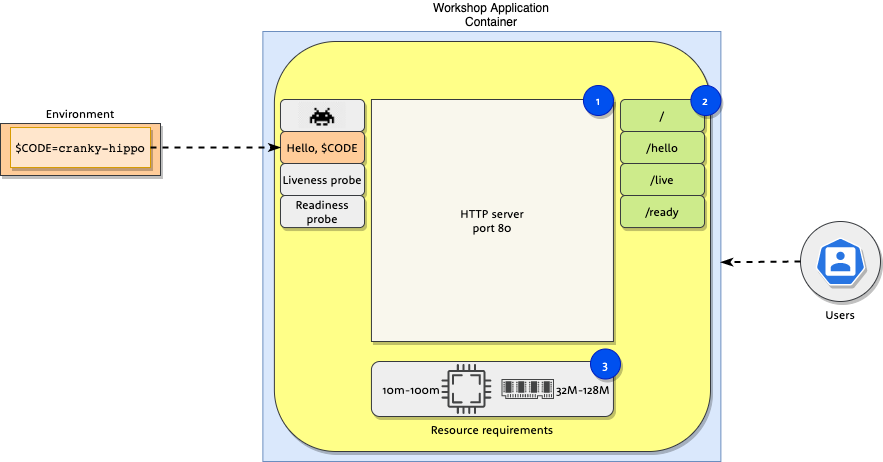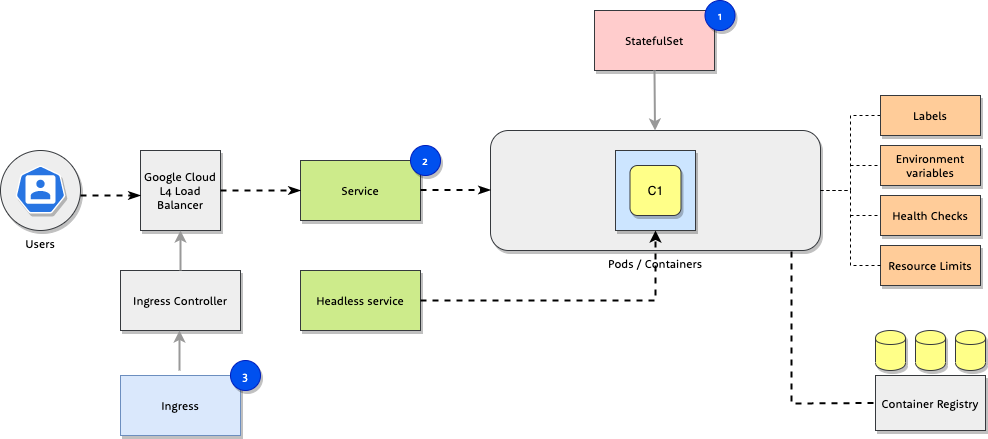Workshop » Basic objects
In this task you will learn how to describe and inspect a simple application as a kubernetes stateful set and expose it to the outside world.
We have prepared a workshop application container with the following features:
- The containerized application is an
httpserver listening on HTTP port80. - There are several
http pathsexposed within the container:/- serves Space Invaders/hello- this path will respond withHello, $CODEmessage, where$CODEis an environment variable set in the definition of a pod./live- Health check liveness probe , where application reports its current status. While the application is running it returnsHTTP 200code. If the application has been running for more than ten minutes, it will respond withHTTP 500error./ready- Health check readiness probe, where application reports if it is ready to accept web request. If the application is ready to accept traffic, this path will respond withHTTP 200response.
- Application resource requirements:
- Between
10mand100mCPU. - Between
32Mand128MMemory.
- Between
Current directory contains three kubernetes objects that are stripped to bare working minimum.
Objects:
StatefulSet- Object containing application definition. This is the file we will be editing in workshop tasks.Service- Object used to expose the application pods internally within the cluster.Ingress- Object to expose the application externally on the URLhttps://$CODE.k8s.3fs.siwhere$CODEis you personalized workshop code.
Your task is to extend the objects with additional options to give Kubernetes more information how to run your application and to align with best practices.
See kubectl cheat sheet for full command reference.
kubectl get all
kubectl describe statefulset/workshop-example
kubectl describe service/workshop-example
kubectl describe ingress/workshop-example
kubectl describe pod/workshop-example-0
kubectl logs -f pod/workshop-example-0
kubectl apply -f service.yaml
kubectl replace --force -f statefulset.yamlCurrent Pod definition in statefulset.yaml lacks definition of annotations.
-
Add the following annotations to
Poddefinition (yaml:.spec.template.metadata.annotations):workshop-name: k8s-workshop-episode-2- any annotation of your choice
-
Update
Poddefinition with the followinglabels(yaml:.spec.template.metadata.labels):code: $CODE, where$CODEis your workshop code
Hint: use example in
statefulset.yaml
After you have updated the statefulset.yaml, deploy the application with the following command.
kubectl apply -f statefulset.yamlInspect the deployed objects by using the following kubectl commands:
kubectl get all
kubectl describe statefulset/workshop-example
kubectl describe pod/workshop-example-0
kubectl logs pod/workshop-example-0Select deployed objects filtering using your label.
kubectl get all -l code=$CODEShow solution
Update file statefulset.yaml. (change cranky-hippo to your workshop $CODE)
--- statefulset.yaml 2020-05-26 17:38:05.000000000 +0200
+++ solutions/01_statefulset.yaml 2020-05-26 17:25:32.000000000 +0200
@@ -14,31 +14,18 @@ spec:
name: workshop-app-example
template:
metadata:
- annotations: {}
+ annotations:
+ workshop: k8s-workshop-episode-2
+ date: "2020-05-27"
labels:
name: workshop-app-example
+ code: cranky-hippo
spec:
containers:
- name: workshop-app-exampleDeploy to cluster:
kubectl replace --force -f statefulset.yamlYou can check the full solution here.
The application is using environment variables for configuration. The environment variable CODE is displayed on HTTP endpoint /hello. You can check that response by visiting https://$CODE.k8s.3fs.si/hello.
Add the environment variables:
CODEwith the value of your workshop code toPoddefinition of theStatefulSet(yaml:.spec.template.spec.containers[0].env)WORKSHOP_USERNAMEwith custom valuek8s-workshop. This value will be used in the future tasks.
Hint: use example in
statefulset.yaml
After you have updated the statefulset.yaml, deploy the application with the following command.
kubectl replace --force -f statefulset.yamlInspect the deployed object by using kubectl describe commands.
kubectl describe statefulset/workshop-example
kubectl describe pod/workshop-example-0Check pods environment by entering the running pod using kubectl exec command and running env command.
kubectl exec pod/workshop-example-0 envShow solution
Update file statefulset.yaml (change cranky-hippo to your workshop $CODE).
--- 01_statefulset.yaml 2020-05-26 17:59:28.000000000 +0200
+++ 02_statefulset.yaml 2020-05-26 17:25:32.000000000 +0200
@@ -25,8 +25,12 @@ spec:
- name: workshop-app-example
image: "eu.gcr.io/k8s-workshop-2/app:latest"
imagePullPolicy: IfNotPresent
- env: []
ports:
- name: http
containerPort: 80
protocol: TCP
+ env:
+ - name: CODE
+ value: "cranky-hippo"
+ - name: WORKSHOP_USERNAME
+ value: "k8s-workshop"Deploy to cluster:
kubectl replace --force -f statefulset.yamlYou can check the full solution here.
The application has no health check configured.
Add health check definitions to Pod definition in StatefulSet:
-
add
livenessProbewith the following definition (yaml key:.spec.template.spec.containers[0].livenessProbe)livenessProbe: httpGet: path: /live port: http
-
add
readinessProbewith the following definition (yaml key:.spec.template.spec.containers[0].readinessProbe)readinessProbe: httpGet: path: /ready port: http
Hint: use example in
statefulset.yaml
After you have updated the statefulset.yaml, deploy the application with the following command.
kubectl replace --force -f statefulset.yamlInspect the pod/workshop-example-0 object by using kubectl describe pod/workshop-example-0 command.
kubectl describe statefulset/workshop-example
kubectl describe pod/workshop-example-0Show solution
Update file statefulset.yaml
--- 02_statefulset.yaml 2020-05-26 17:25:32.000000000 +0200
+++ 03_statefulset.yaml 2020-05-26 17:25:32.000000000 +0200
@@ -34,3 +34,11 @@ spec:
value: "cranky-hippo"
- name: WORKSHOP_USERNAME
value: "cranky-hippo"
+ livenessProbe:
+ httpGet:
+ path: /live
+ port: http
+ readinessProbe:
+ httpGet:
+ path: /ready
+ port: httpDeploy to cluster:
kubectl replace --force -f statefulset.yamlYou can check the full solution here.
Current definition of StatefulSet lacks information about resource usage.
Update definition of Pod in StatefulSet with the following limits:
- when the container is starting, it should requests
10mof CPU time and32Mof memory. - the container should be limited to
100mof CPU time and128Mof memory
Use the following definitions in .spec.template.spec.containers[0].resources:
requests:
cpu: 10m
memory: 32Mi
limits:
cpu: 100m
memory: 128MiWithin the workshop console container updated StatefulSet definition to the cluster:
kubectl replace --force -f statefulset.yamlInspect the pod/workshop-example-0 object with kubectl command.
kubectl describe pod/workshop-example-0Show solution
Update file statefulset.yaml
--- 03_statefulset.yaml 2020-05-26 17:25:32.000000000 +0200
+++ 04_statefulset.yaml 2020-05-26 17:25:43.000000000 +0200
@@ -42,3 +42,10 @@ spec:
httpGet:
path: /ready
port: http
+ resources:
+ requests:
+ cpu: 10m
+ memory: 32Mi
+ limits:
+ cpu: 100m
+ memory: 128MiDeploy to cluster:
kubectl replace --force -f statefulset.yamlYou can check the full solution here.
Expose the application inside Kubernetes cluster by deploying a service. It is defined in service.yaml.
Pods running in Kubernetes will now be able to talk to your application on port 80 using the service.
kubectl describe service/workshop-exampleShow solution
Deploy to cluster:
kubectl apply -f service.yamlTo expose the service to Internet Ingress object needs to be created. Additionally, if we want to use HTTPS, the certificate has to be present in the kubernetes environment. The certificate must be stored in kubernetes Secret object and referenced in Ingress definition.
A .yaml file to create the wildcard certificate secret is located in the /
folder of Docker container. This object will be important in the future tasks.
Apply it using the following command:
kubectl create -f /k8s.3fs.si-cert.yamlAfter successful import of certificate Secret object, we can create Ingress object to expose service to Internet.
To expose the service to the Internet edit hostname in
ingress.yaml to include $CODE (e.g.
cranky-hippo.k8s.3fs.si). To edit file you can use included vim or nano
editors (quick guide how to use them is
here).
The spec section should look similar to:
tls:
- hosts:
- "cranky-hippo.k8s.3fs.si"
secretName: k8s.3fs.si-certificate
rules:
- host: "cranky-hippo.k8s.3fs.si"
http:
paths:
- path: /
backend:
serviceName: workshop-example
servicePort: 80Create the Ingress object named workshop-example using the following command.
kubectl apply -f ingress.yamlInspect the ingress object.
kubectl describe ingress workshop-exampleYour workshop application has now been deployed. Replace $CODE with your workshop code.
Access:
- Space invaders:
https://$CODE.k8s.3fs.si. - Hello:
https://$CODE.k8s.3fs.si/hello.
Kubernetes dashboard:
- All deployed resources: https://dashboard.k8s.3fs.si/#/overview?namespace=$CODE
- Pod information: https://dashboard.k8s.3fs.si/#/pod/$CODE/workshop-example-0?namespace=$CODE
- Logs: https://dashboard.k8s.3fs.si/#/log/$CODE/workshop-example-0/pod?namespace=$CODE
Things to check:
- Pod CPU and Memory Resource consumption
- Pod Metadata
- Pod container environment variables
- Pod Events (hint: pod liveness probe will fail after 10min.)
- Pod Logs
- Service definition
- Ingress definition
- Secret used for HTTPS

